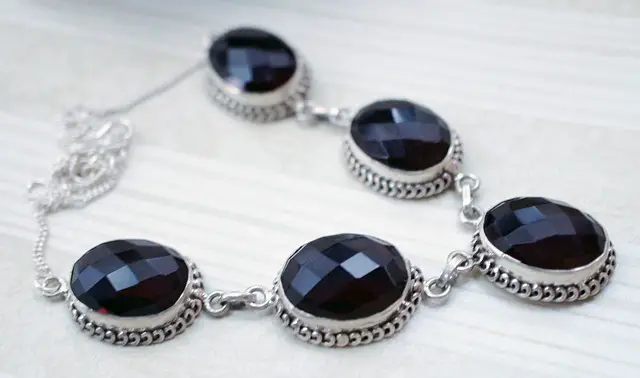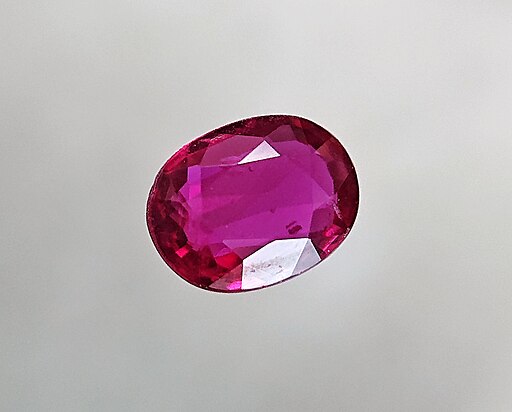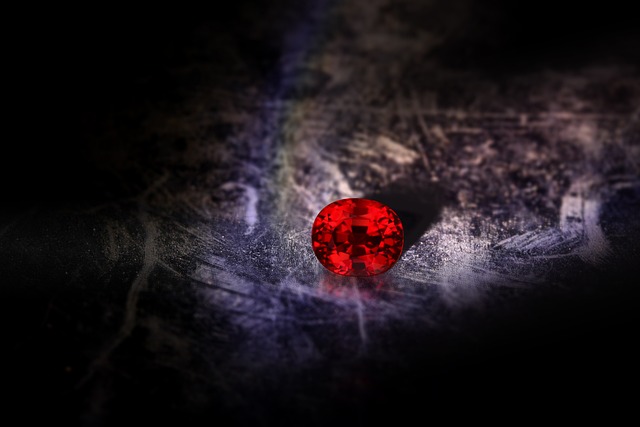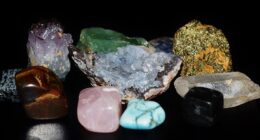Garnet and ruby are both gemstones, but they differ in color and chemical composition. Garnet comes in various colors, while ruby is red and belongs to the corundum family.
TL;DR Garnet Vs. Ruby
Garnet is a group of minerals that come in many different types, each with its unique features. It is a silicate mineral that can range in color from deep red to vibrant green, and even colorless. Garnets have different physical and chemical properties depending on their specific type.
On the other hand, Ruby is a variety of the mineral corundum, which also includes sapphires. Rubies are known for their intense red color, which is a result of the presence of chromium in the crystal structure. They possess specific physical and chemical properties that distinguish them from other gemstones.
What is Garnet?

Garnet, a fascinating gemstone with a rich history, comes in various types and possesses unique physical and chemical properties. In this section, we’ll dive into the captivating world of garnet, exploring its different types and uncovering the intriguing facts surrounding its physical and chemical characteristics. Prepare to be amazed by the diversity and allure of this exquisite gem.
Types of Garnet
Here is a table highlighting different types of garnet:
| Types of Garnet | Description |
| Almandine | A deep red to reddish-brown variety of garnet with a high refractive index. |
| Pyrope | A bright red variety of garnet often used as a gemstone. |
| Grossular | A green, yellow, or brown variety of garnet. It can also be colorless or pink. |
| Spessartine | Also known as mandarin garnet, it is an orange to reddish-brown variety. |
| Andradite | Has various colors including yellow, green, and brown. It is also known for its high dispersion. |
| Uvarovite | A rare green variety of garnet that is known for its drusy texture. |
Pro-tip: When choosing a garnet for jewelry or other purposes, consider the specific type of garnet and its color, as different types have varying colors and characteristics. Consult with a gemologist or expert to ensure the authenticity and quality of the garnet you are considering.
Physical and Chemical Properties
| Physical and Chemical Properties | Garnet | Ruby |
| Chemical Formula | X3Y2(SiO4)3 | Al2O3 |
| Hardness on Mohs Scale | 6.5-7.5 | 9 |
| Specific Gravity | 3.5-4.3 | 3.97-4.05 |
| Refractive Index | 1.72-1.94 | 1.76-1.78 |
| Crystal System | Isometric | Trigonal |
| Color | Various colors including red, green, yellow, orange, and brown | Red |
Garnet possesses both physical and chemical properties that can be compared and contrasted with those of ruby. By examining the table, one can observe the differences between these two gemstones based on their chemical formulas, hardness on the Mohs scale, specific gravity, refractive indices, crystal systems, and color.
Garnet’s chemical formula is X3Y2(SiO4)3, where X represents calcium, magnesium, or ferrous iron, and Y represents aluminum, chromium, or ferric iron. It exhibits a hardness ranging from 6.5 to 7.5 on the Mohs scale, a specific gravity that falls between 3.5 and 4.3, and a refractive index ranging from 1.72 to 1.94. In terms of crystal system, garnet crystals are classified as isometric. Furthermore, garnets can be found in various colors, including red, green, yellow, orange, and brown.
Ruby has a chemical formula of Al2O3. It stands out due to its exceptional hardness of 9 on the Mohs scale, a specific gravity ranging from 3.97 to 4.05, and a refractive index between 1.76 and 1.78. In contrast to garnet, ruby crystals belong to the trigonal crystal system and are renowned for their deep red color.
What is Ruby?

Ruby, a captivating gemstone loved for centuries, holds an enchanting tale waiting to be discovered. This section will unravel the secrets of this precious stone, exploring its unique characteristics and delving into its physical and chemical properties. From its rich history to its vibrant hues, get ready to immerse yourself in the fascinating world of ruby. Join us as we journey through the wonders of this remarkable gem and uncover the captivating story that lies within.
Characteristics of Ruby
The characteristics of Ruby are:
- Color: Ruby is distinguished by its vibrant red color. It ranges from pinkish-red to deep crimson, with the most valuable rubies being a pure, intense red.
- Hardness: Ruby stands as one of the hardest gemstones, ranking 9 on the Mohs scale. This attribute makes it remarkably durable and suitable for everyday wear.
- Clarity: Rubies can possess varying levels of clarity, with inclusions being common. High-quality rubies with exceptional clarity hold substantial value.
- Lustre: Ruby displays a vitreous lustre when polished, imparting a brilliant shine.
- Transparency: Rubies can exhibit transparency or opacity. The greater the transparency, the more valuable the ruby becomes.
- Size: Rubies can vary in size, but large rubies are infrequent and command higher prices.
- Origin: The origin of a ruby can influence its value and attributes. Rubies from Myanmar (formerly Burma) are highly sought after due to their intense red color.
- Fire: When light passes through a ruby, it emanates a captivating red glow referred to as fire. The intensity of the fire adds to the allure of the gemstone.
Physical and Chemical Properties
The physical and chemical properties of garnet and ruby can be compared using the following table:
| Properties | Garnet | Ruby |
|---|---|---|
| Chemical Formula | X3Y2(SiO4)3 | Al2O3 |
| Crystal System | Cubic | Hexagonal |
| Hardness | 6.5 – 7.5 | 9 |
| Luster | Vitreous | Adamantine |
| Color | Various colors, including red, green, orange, yellow, and brown | Red |
| Refractive Index | 1.73 – 1.89 | 1.76 – 1.78 |
| Specific Gravity | 3.5 – 4.3 | 4 |
Garnet and ruby are both gemstones with distinct physical and chemical properties. The physical properties include hardness, luster, color, refractive index, and specific gravity. The chemical properties are determined by their respective chemical formulas and crystal systems.
Garnet has a chemical formula of X3Y2(SiO4)3 and crystallizes in a cubic crystal system. It has a hardness ranging from 6.5 to 7.5 and a vitreous luster. Garnet can occur in various colors, including red, green, orange, yellow, and brown. It has a refractive index ranging from 1.73 to 1.89 and a specific gravity ranging from 3.5 to 4.3.
On the other hand, ruby has a chemical formula of Al2O3 and crystallizes in a hexagonal crystal system. It is significantly harder than garnet, with a hardness of 9 on the Mohs scale. Ruby has an adamantine luster and is primarily known for its red color. It has a refractive index ranging from 1.76 to 1.78 and a specific gravity of 4.
While both garnet and ruby are beautiful gemstones, they differ in terms of their chemical composition, crystal structure, hardness, color, and other physical properties.
Comparison Between Garnet and Ruby
When it comes to garnet and ruby, what sets them apart? In this comparison, we’ll explore the fascinating world of these gemstones. From their composition and structure to their vibrant colors and varieties, we’ll uncover the distinctive characteristics that make each stone truly unique. We’ll also delve into the aspects of hardness and durability, as well as the value and rarity of these precious gems. Get ready to dive into the dazzling realm of garnet and ruby and discover what makes them stand out in the world of gemstones.
Composition and Structure
The composition and structure of garnet and ruby are different, resulting in distinct properties and characteristics.
| Composition | Garnet: A group of closely related minerals composed of aluminum, iron, calcium, and other elements. | Ruby: A variety of the mineral corundum consisting primarily of aluminum and oxygen, with traces of chromium responsible for its red color. |
| Crystal Structure | Garnet: Garnets are typically cubic or rhombic dodecahedral in shape with a symmetrical crystal structure. | Ruby: Rubies have a hexagonal crystal structure, forming prismatic or tabular crystals. |
The composition of garnet includes aluminum, iron, calcium, and other elements, while ruby is primarily composed of aluminum and oxygen, with traces of chromium. In terms of crystal structure, garnet crystals are typically cubic or rhombic dodecahedral, whereas ruby crystals have a hexagonal structure, forming prismatic or tabular shapes.
Color and Varieties
When comparing the color and varieties of garnet and ruby, it is important to note that both gemstones display a wide range of hues, each with its own unique characteristics.
| Gemstone | Color Range | Varieties |
|---|---|---|
| Garnet | Can be found in a variety of colors including red, orange, yellow, green, purple, brown, black, and colorless. | Popular varieties include Almandine, Pyrope, Spessartine, Grossular, Andradite, and Uvarovite. |
| Ruby | Known for its diverse color range, from pinkish-red to purplish-red. | No specific varieties, as all rubies belong to the corundum mineral species. |
Garnet exhibits a broader spectrum of colors and varieties compared to ruby, allowing for more options in gemstone selection. While garnets can be found in a multitude of colors, rubies are exclusively prized for their intense red color. Both gemstones are highly valued for their beauty and can make stunning centerpieces in jewelry.
Hardness and Durability
When comparing the hardness and durability of garnet and ruby, it is important to consider their physical properties.
| Criteria | Garnet | Ruby |
| Hardness | Garnet has a hardness of 6.5 to 7.5 on the Mohs scale, making it relatively durable and resistant to scratching. | Ruby is one of the hardest gemstones, with a hardness of 9 on the Mohs scale. This makes it highly durable and well-suited for everyday wear. |
| Durability | Garnet has good durability and can withstand daily wear. It may be more prone to chipping or cracking due to its lower hardness compared to ruby. | Ruby is extremely durable and has excellent resistance to scratching and chipping. It is a popular choice for engagement rings and other jewelry that requires long-lasting durability. |
The difference in hardness and durability between garnet and ruby is primarily due to their different chemical compositions and crystal structures. Ruby is composed of corundum, a mineral consisting of aluminum oxide, while garnet is a group of minerals with varying compositions. This difference in composition contributes to ruby’s superior hardness and durability.
A true story that illustrates the exceptional durability of ruby is that of the “Black Prince’s Ruby,” which is set in the British Imperial State Crown. This historical gemstone has survived for centuries and has been passed down through royal generations. Its resilience and enduring beauty serve as a testament to the hardness and durability of ruby as a gemstone.
Value and Rarity
We can compare the value and rarity of garnet and ruby by using a table that highlights their differences in terms of price and availability.
| Criteria | Garnet | Ruby |
|---|---|---|
| Price per carat | $100 – $3,000 | $1,000 – $15,000 |
| Availability | Abundant | Rare |
| Color Varieties | Red, orange, yellow, green, brown, black | Red |
| Hardness | 6.5 – 7.5 on the Mohs scale | 9 on the Mohs scale |
| Rarity | Common | Rare |
Garnet is more affordable compared to ruby, with prices ranging from $100 to $3,000 per carat. On the other hand, ruby is significantly more expensive, with prices ranging from $1,000 to $15,000 per carat.
When it comes to availability, garnet is considered abundant and offers a wide range of color varieties including red, orange, yellow, green, brown, and black. In contrast, ruby is rarer and can only be found in shades of red.
In terms of hardness, garnet has a rating of 6.5 to 7.5 on the Mohs scale, making it less durable than ruby, which has a hardness rating of 9.
Garnet is more readily available and affordable compared to ruby. However, ruby’s rarity and its unique red color contribute to its higher value in the gemstone market.
Throughout history, garnets have been cherished for their beauty and healing properties. They were believed to possess the power to protect against evil and enhance creativity in ancient times. Even today, garnets remain highly regarded gemstones, appreciated for their stunning colors and affordability.
In contrast, rubies have an illustrious history and have been treasured as one of the most valuable gemstones for centuries. They have been associated with wealth, power, and passion. Rubies have adorned the crowns of kings and queens and are highly sought after by collectors and connoisseurs worldwide.
The value and rarity of garnet and ruby differ significantly, with garnet being more affordable and accessible, while ruby is prized for its scarcity and vibrant red color.
Uses of Garnet
Garnet is a gemstone that has various uses in different industries and applications. Here are some common uses of garnet:
- Jewelry: Garnet is widely used in jewelry design. Its beautiful deep red color and excellent durability make it a popular gemstone for rings, necklaces, earrings, and bracelets.
- Abrasive Material: Due to its hardness, garnet is used as an abrasive material in various industries. It is commonly used in sandpaper, sandblasting, and waterjet cutting applications. Garnet abrasives are valued for their effectiveness in removing rust, paint, and other coatings.
- Water Filtration: Garnet is used in water filtration systems to remove impurities and sediment from drinking water. Its high density and angular shape allow it to effectively filter out particles and provide clean water.
- Industrial Applications: Garnet’s hardness and heat resistance make it suitable for industrial applications. It is used in the production of grinding wheels, cutting tools, and specialized machinery parts.
- Geological Studies: Garnet is an important mineral in geological studies. Its presence in rocks and minerals provides valuable insights into the geological history and formation of certain areas. It is also used as a mineral indicator to determine the pressure and temperature conditions during metamorphism.
- Abrasive Blasting: Garnet is used in abrasive blasting processes to clean and prepare surfaces for painting, coating, or repair. It effectively removes contaminants and old coatings without damaging the underlying material.
These are just a few examples of the many uses of garnet. Its versatility and unique properties make it a valuable gemstone and material in various industries.
Uses of Ruby
The gemstone Ruby has various uses and applications, including:
- Jewelry: Ruby is a highly sought-after gemstone for use in jewelry. Its deep red color and exceptional hardness make it a popular choice for engagement rings, earrings, necklaces, and other exquisite pieces.
- Collectibles and Investment: Fine-quality rubies are considered valuable collectibles and can be a good investment. Rare and high-quality rubies with desirable characteristics, such as intense color and minimal inclusions, can appreciate in value over time.
- Astrology and Spirituality: Ruby holds significance in astrology and spirituality. It is associated with the sun and is believed to bring prosperity, passion, and vitality to the wearer. It is often used in gemstone therapies and rituals.
- Symbolism: Ruby is often used as a symbol of love, passion, and courage. It is frequently used in special occasions, such as anniversaries or romantic gestures, to convey deep emotions and affection.
- Metaphysical Properties: Ruby is believed to possess metaphysical properties, including the ability to enhance energy, stimulate the heart chakra, and promote positivity and self-confidence. It is considered a stone of strength and vitality.
- Birthstone: Ruby is the birthstone for the month of July. It is cherished by individuals born in this month and is often incorporated into birthstone jewelry.
- Historical and Cultural Significance: Ruby has a rich history and cultural significance in various civilizations. It has been prized and revered in different cultures, including Ancient Egypt, India, and Medieval Europe.
- Scientific and Industrial Applications: Ruby’s exceptional hardness and thermal conductivity make it useful in scientific and industrial applications. It is employed in lasers, scientific instruments, watchmaking, and certain specialized technologies.
These are some of the notable uses and significance of the gemstone Ruby, making it a highly valued and cherished gem in various domains.
Frequently Asked Questions
What’s the difference between garnet and ruby in terms of appearance?
Garnets come in multiple color variations, showing hints of purple and blue, while rubies are typically a deeper red shade with a fiery red undertone. Rubies also tend to have a deeper tone compared to garnets.
How can I differentiate between a garnet and a ruby?
One way to tell the difference is by looking at their color under different light sources. Holding a garnet up to the light will reflect a rainbow of colors, while rubies tend to absorb green and yellow. Rubies also have a deeper red coloring compared to garnets.
Are garnets and rubies formed differently?
Yes, the geological formation processes of garnets and rubies are different. Garnets are a group of silicates formed through a volcanic forming process, while rubies are composed of corundum, formed through a different process involving aluminum and oxygen atoms.
Which gemstone is more durable, garnet or ruby?
Rubies are more durable than garnets. Rubies rank 9 on the Mohs scale of hardness, making them the second-hardest gemstone after diamonds. Garnets, on the other hand, have a hardness of 6.5 to 7.5, making them a softer stone compared to rubies.
Are there any distinguishing features between rubies and garnets when examined closely?
Yes, one key distinguishing feature is the presence of inclusions. Rubies can contain nine types of inclusions, which may be visible to the untrained eye, while red garnets generally do not have eye-visible inclusions. Additionally, lab-grown rubies closely imitate the natural formation process and contain few to no inclusions.
What is the price difference between garnets and rubies?
Ruby is generally more expensive than garnet due to its relative rarity and unmatched saturation of red. High-quality rubies can range from a few hundred USD to over $100,000 USD per carat. In contrast, garnets range from $150 USD to a maximum of $7,000 USD per carat. Additionally, garnets are more affordable and available in larger sizes compared to rubies.
Image Credits
Featured Image By – Mathieu Kessler from Pixabay
Image 1 By – starbright from Pixabay
Image 2 By – Sasaki kijinuko, CC BY-SA 4.0 , via Wikimedia Commons








